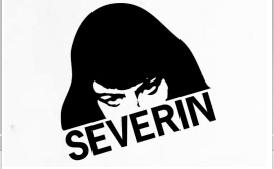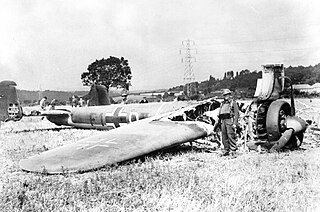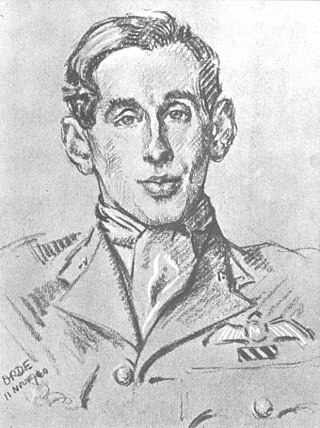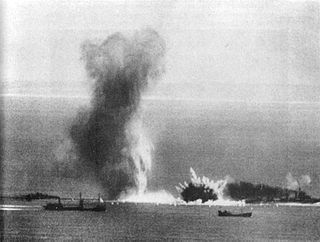
The Battle of Britain was a military campaign of the Second World War, in which the Royal Air Force (RAF) and the Fleet Air Arm (FAA) of the Royal Navy defended the United Kingdom (UK) against large-scale attacks by Nazi Germany's air force, the Luftwaffe. It was the first major military campaign fought entirely by air forces. The British officially recognise the battle's duration as being from 10 July until 31 October 1940, which overlaps the period of large-scale night attacks known as the Blitz, that lasted from 7 September 1940 to 11 May 1941. German historians do not follow this subdivision and regard the battle as a single campaign lasting from July 1940 to May 1941, including the Blitz.

Battle of Britain is a 1969 British war film directed by Guy Hamilton, and produced by Harry Saltzman and S. Benjamin Fisz. The film documents the events of the Battle of Britain. The film drew many respected British actors to accept roles as key figures of the battle, including Laurence Olivier as Air Chief Marshal Sir Hugh Dowding, Trevor Howard as Air Vice-Marshal Keith Park, and Patrick Wymark as Air Vice-Marshal Trafford Leigh-Mallory. It also starred Michael Caine, Christopher Plummer, and Robert Shaw as Squadron Leaders. The script by James Kennaway and Wilfred Greatorex was based on the book The Narrow Margin by Derek Wood and Derek Dempster.

No. 303 Squadron RAF, also known as the 303rd "Tadeusz Kościuszko Warsaw" Fighter Squadron, was one of two Polish squadrons that fought during the Battle of Britain along with No. 302 Squadron, of 16 total Polish squadrons during the Second World War. Flying Hawker Hurricanes, the squadron claimed the largest number of aircraft shot down of the 66 Allied fighter squadrons engaged in the Battle of Britain, even though it joined the fray two months after the battle had begun.

Piece of Cake is a 1988 British six-part television serial depicting the life of a Royal Air Force fighter squadron from the day of the British entry into World War II through to one of the toughest days in the Battle of Britain. The series was produced by Holmes Associates for LWT for ITV and had a budget of five million pounds.

The Inglorious Bastards is a 1978 Italian Euro War film directed by Enzo G. Castellari and starring Bo Svenson, Peter Hooten, Fred Williamson, Jackie Basehart, and Ian Bannen. The film, which concerns a group of prisoners who are drafted into a special war mission in 1944, is a loose (unauthorized) remake of the 1967 American film The Dirty Dozen.

Wing Commander Brendan Eamonn Fergus Finucane,, known as Paddy Finucane amongst his colleagues, was an Irish Second World War Royal Air Force (RAF) fighter pilot and flying ace—defined as an aviator credited with five or more enemy aircraft destroyed in aerial combat.

Enzo Girolami Castellari is an Italian film director, screenwriter and actor.

James Harry Lacey,, was one of the top scoring Royal Air Force fighter pilots of the Second World War and was the second-highest scoring RAF fighter pilot of the Battle of Britain, behind Pilot Officer Eric Lock of No. 41 Squadron RAF. Lacey was credited with 28 enemy aircraft destroyed, five probables and nine damaged.

Battle of Britain Day, 15 September 1940, is the day on which a large-scale aerial battle in the Battle of Britain took place.

Escape from the Bronx, also known as Bronx Warriors 2 in the United Kingdom and Escape 2000, is a 1983 Italian action film directed by Enzo G. Castellari. It was featured on Mystery Science Theater 3000 under its Escape 2000 name. It is a sequel to 1990: The Bronx Warriors.

No. 238 Squadron is a squadron of the Royal Air Force. It was first formed in 1918 by combining number 347, 348 and 349 Flights at RAF Cattewater by the Royal Flying Corps during the First World War. It was reformed for the Second World War, the Berlin Airlift and currently is a Line Training Flight (LTF) squadron based at RAF Cosford, albeit in a non-flying capacity. It is among those officially acknowledged Battle of Britain squadrons.
Euro War, also known as Macaroni Combat, Macaroni War, Spaghetti Combat, or Spaghetti War, is a broad subgenre of war film that emerged in the mid-1960s. The films were named Euro War because most were European co-productions, most notably and commonly by Italians, as indicated by the subgenre's other nicknames that draw parallels to those films within the mostly Italian Spaghetti Western genre.

Severin Films is an American film production and distribution company known for restoring and releasing cult films on DVD and Blu-ray. It is considered a boutique Blu-ray and DVD label.

The Hardest Day was a Second World War air battle fought on 18 August 1940 during the Battle of Britain between the German Luftwaffe and British Royal Air Force (RAF). On that day, the Luftwaffe made an all-out effort to destroy RAF Fighter Command. The air battles that took place on that day were amongst the largest aerial engagements in history to that time. Both sides suffered heavy losses. In the air, the British shot down twice as many Luftwaffe aircraft as they lost. However, many RAF aircraft were destroyed on the ground, equalising the total losses of both sides. Further large and costly aerial battles took place after 18 August, but both sides lost more aircraft combined on this day than at any other point during the campaign, including 15 September, the Battle of Britain Day, generally considered the climax of the fighting. For this reason, Sunday 18 August 1940 became known as "the Hardest Day" in Britain.

Zdzisław Karol Henneberg VM, DFC, KZ***, CdeG was a Polish airman who flew with the Royal Air Force during the Battle of Britain and a flying ace of the Second World War.

John Charles Dundas, was a Royal Air Force fighter pilot and flying ace of the Second World War credited with 12 victories.

Eagle Squadron is a 1942 American war film directed by Arthur Lubin and starring Robert Stack, Diana Barrymore, John Loder and Nigel Bruce. It was based on a story by C.S. Forester that appeared in Cosmopolitan magazine, and inspired by media reports of the fighting in the Battle of Britain, in particular, the American pilots who volunteered before the United States entered World War II, to fly for the Royal Air Force in the actual Eagle Squadrons.

The Kanalkampf was the German term for air operations by the Luftwaffe against the Royal Air Force (RAF) over the English Channel in July 1940, beginning the Battle of Britain during the Second World War. By 25 June, the Allies had been defeated in Western Europe and Scandinavia. Britain had rejected peace overtures and on 16 July, Adolf Hitler issued Directive 16 to the Wehrmacht, ordering preparations for an invasion of Britain, under the codename Unternehmen Seelöwe.

Group Captain Francis Victor Beamish, was an Irish-born Royal Air Force fighter pilot and flying ace of the Second World War. After flying during the Battle of Britain he continued to lead fighter operations until he was killed in action in 1942.
Fighter-bomber attacks on the United Kingdom during World War II were conducted by the German Luftwaffe during the Second World War.


















